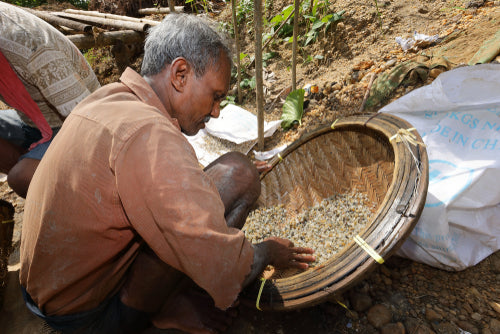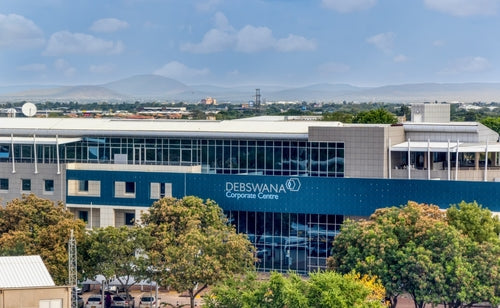
Ethics and Sustainability
Question: Are there any sustainable or ethical practices that you incorporate into your business (e.g., eco-friendly materials, responsible sourcing)? And also, what values do you want The Finest Stack to reflect?
Annika: This is truly where the rubber meets the road when you see the words “The Finest” in my brand name! Not everyone worries about where their diamonds are sourced or where their gemstones come from, but there are lots of socially and ethically conscious consumers and brands that are out there who do. I am one of them, and I really do.
The majority of the gold that I use in my pieces is recycled gold, ethically sourced, and comes from India. Not ALL recycled gold, however, is considered ethically sourced, which is why it’s important to ask questions! I work with small family-owned gold refineries in India who take great care in recycling gold from electronics, industrial waste, and old jewelry. Contrast that with larger refineries who oftentimes sell to huge manufacturing companies in large southeast Asian countries. These huge companies do recycle old gold but they also mix in newly mined gold, which may have been mined using unethical practices or under poor conditions. Mixing this new gold in with the recycled portion of gold still enables them to label it “recycled.” This is an important distinction to make when, as a consumer, you are trying to obtain ethically sourced, feel-good pieces of jewelry. As the price of gold continues to increase, the smaller family-owned refineries who truly use recycled gold are thankfully becoming more popular. I am happy to align myself with the family-owned refineries who truly are using recycled old gold and NOT hiding behind semantics.
For precious gemstones, the rubies and sapphires that I use come from Sri Lanka. Sri Lankans are very traditional people and the Sri Lankan government fiercely protects them with strict mining laws. The miners and their families must abide by strict mining rules. Gem mining follows traditional Sri Lankan methods, mining by hand, which is a method that has been used for centuries. Many gem mines are owned by families who have owned the same mine for multiple decades. Families are seen praying before moving onto the next layer during the mining process This is an age-old ritual. Additionally, when a gem is found, a huge celebration occurs. There is so much pride in their work and tremendous respect for the elders in the family. And when the elders pass on their knowledge to the next generation... well, that is an enormous gift.
As for diamonds, my diamonds come from Botswana. Lots of people speak of The Kimberley Process. The Kimberley Process was created with the best of intentions, but there are weaknesses that not many know or understand. The Kimberley Process (named after a mine in Kimberley, South Africa, which is now closed) only flags diamonds linked to rebel groups fighting against recognized governments-- this is the definition of the Kimberley Process. Human rights abuses are not in its definition. If a diamond isn't funding rebel groups, it can still be cut, polished, and sold, though it may still come from a controversial mine. “Unfair labor practices and human-rights abuses don’t disqualify diamonds under the [Kimberley Process], while the definition of conflict is so narrow as to exclude many instances of what consumers would, using common sense, think of as a conflict diamond…When, in 2008, the Zimbabwean army seized a major diamond deposit in eastern Zimbabwe and massacred more than 200 miners, it was not considered a breach of the Kimberley Process protocols. ‘Thousands had been killed, raped, injured, and enslaved in Zimbabwe, and the Kimberley Process had no way to call those 'conflict diamonds' because there were no rebels.’” (Baker, A. (2015, August 27). Blood Diamonds. Retrieved April 19, 2019, TIME Magazine, https://time.com/blood-diamonds/ )
The Kimberley Process doesn't cover broader issues like human rights abuses, which is truly terrifying and can also undermine the natural diamond business. Who wants to wear a diamond that has caused rape or murder? Positive emotional value is the most important thing to me. We definitely cannot sell luxury products that cause death, rape, destruction, or any sort of human rights violation. Martin Rapaport says it best: “The fact that almost all diamond trade organizations support the Kimberley Process (KP), which certifies blood diamonds as being legitimate, has set the stage for the destruction of our industry. If we do not separate good diamonds from bad diamonds, we do not deserve to be in business.” (Rapaport Source Certification, by M. Rapaport, Rapaport.com)
I work very hard to ensure that every material I use is sourced with care and concern for other human beings. All of the diamonds in my pieces come from Botswana and are cut and polished in either New York City or India. Every diamond purchased from The Finest Stack that is equal to or greater than one carat will come to you with its own portfolio from the Gemological Institute of America (GIA), a widely respected nonprofit association and considered the gold standard for grading of natural diamonds. This official portfolio guarantees the authenticity and integrity of your natural diamond, certifies that each diamond has been examined by 3 independent gemologists, that each stone is inscribed with its own serial number, and also provides you with the diamond's country of origin.
And that brings me to the history of diamonds from Botswana. Botswana used to be owned by the British Empire and was a very poor country. In 1966, when Botswana became an independent country, enormous diamond deposits were discovered. In 1967, The De Beers Group (which holds the purse strings worldwide to the diamond industry) and Botswana joined forces to create a program called Debswana. Debswana operates four mines—Orapa, Letlhakane, Jwaneng, and Damtshaa—and is the second-largest employer in Botswana, after the government. The Botswana government owns about 15% of De Beers, which affords it the ability to manage how diamond revenue is managed. Much of the income from Debswana goes into government funds, supporting projects like building schools, roads, education, bringing clean drinking water to homes and farms, and wildlife and rhino conservation. It is truly impressive how the government and the diamond industry have come together to create so much progress and industry in Botswana, when before 1966, the YEARLY take-home income of a family was $80/year. And now, because of Debswana, Botswana is able to reinvest in other industries which will only help the country further. This type of story sticks with me and makes me feel confident in what I am doing and eager to tell the story of how diamonds have built the infrastructure of an entire country.
I don’t think I could sleep at night NOT knowing where my materials have come from. I do know that I cannot sell luxury items that could be possibly be attributed to rape, death, torture, or any other horrible abuse. Like Martin Rapaport states, "A customer receiving a diamond that can be shown to have made the world a better place is proud of that diamond and will wear it with honor and tell her friends about the story– these are all positive things.” Even my packaging is paper based and easily recyclable, so you can feel good about that, too!! Creating positive emotional value is what The Finest Stack is all about—-and is what the whole jewelry industry should be about!
DeBeers + Botswana = Debswana
The DeBeers Group joined forces with the government of Botswana to form DEBSWANA. DEBSWANA operates four enormous diamond mines in Botswana. This has enabled Botswana to own about 15% of DeBeers, which then affords Botswana the ability to manage how its diamond revenue is allocated. The majority of it goes back into Botswana and toward building schools, roads, providing clean drinking water to homes and farms, and to wildlife conservation.

